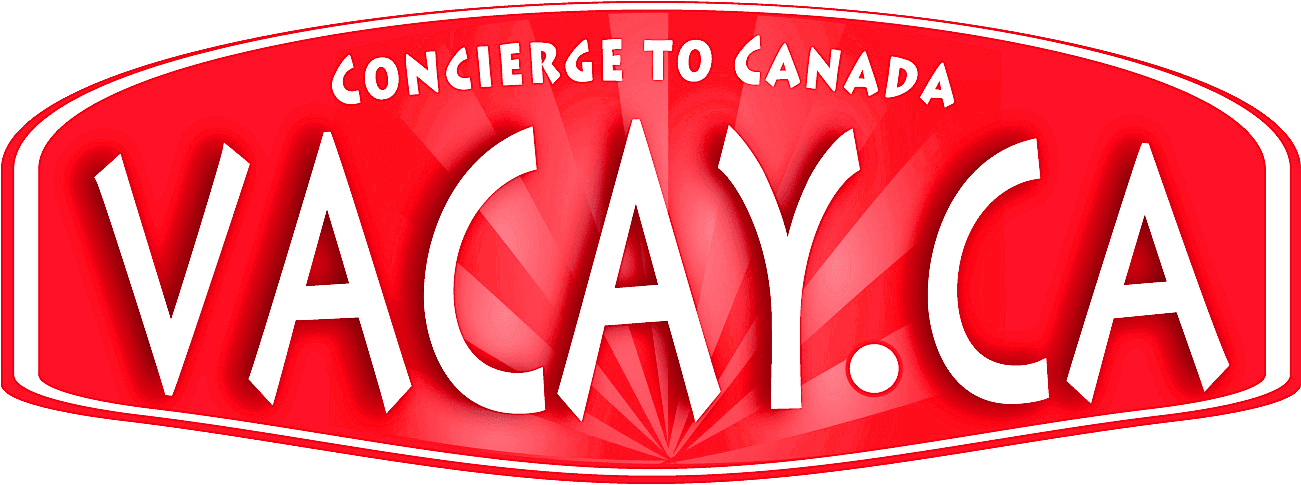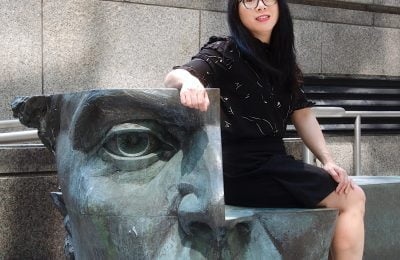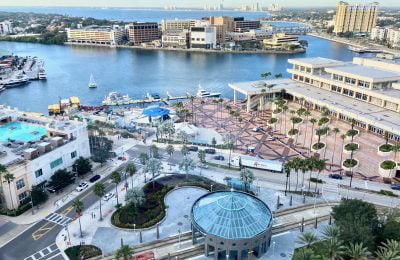
Coffee is a thing in Hamilton. There are more than 60 independent coffee shops in the city, and trucks such as this one by Manual Labour. (Julia Pelish/Vacay.ca)
Commentary by Adrian Brijbassi
Vacay.ca Managing Editor
Hamiltonians, based on several social media responses to an article I published on Vacay.ca last week, clearly desire to be recognized as residents of a great city with a culinary environment important to the national food scene. They won’t receive such recognition from me.
What Hamiltonians will get are words that reinforce positions of their municipal leaders and those hired to market the city: Theirs is a “rising” city with a “burgeoning arts scene” and an “emerging” culinary sector, giving it the “potential” for significant tourism growth by 2020.
Last year, the City of Hamilton‘s tourism development arm published a strategy plan focused on increasing awareness of the city’s offerings for visitors, with a focus on attracting more convention business. Among the top priorities it lists is a need to change the “negative marketplace perceptions of Hamilton as a destination.” The reason why is clear. Not enough people who do not already know Hamilton are coming. By far the No. 1 category of visitor is friends and relatives of Hamiltonians. That category of tourist rarely books a night at a hotel room and isn’t likely to spend money on the city’s tourism and hospitality businesses. In fact, “only 4% of all of the person trips to Hamilton involve overnight stays in commercial accommodation,” states the action plan. You can read about it here.
On the other hand, a bona fide tourist — a stranger who has decided to allocate hers or his valuable time exploring a destination — is excited to be in an unfamiliar place and will spend dollars. Hotel room income remains the key for most tourism-based revenue streams. Restaurants are big beneficiaries because an overnight visitor will buy dinner, enjoy it with a bottle of wine, and if all goes right return to a hotel room happily fed, slightly intoxicated, and eager to share the news on social media about the good time being had.
Thriving tourism markets have grown through a recipe that basic. Three examples:
• In 1999, actor Dylan McDermott called Calgary a “boot camp” with “nothing to eat and nothing to do” and with neighbouring communities that mistook “ketchup for tomato sauce.” Calgarians were enraged, but also resolute. An influx of culinary talent arrived in the city — in many cases they were chefs returning home after improving their skills abroad. They established a collaborative approach, realizing if one chef or restaurant does exceedingly well in terms of accolades such as strong reviews or industry awards, it reflects well on the entire city. Michael Noble, who was one of the earliest chefs to establish contemporary quality cuisine in Calgary, told me as much this spring when he said, “Collaboration works because we are able to spread things around and get our name out there as a city.” In 2010, one of Calgary’s gems, Rouge, landed on the San Pellegrino rankings of the World’s Best Restaurants. In 2013, Calgary placed eight restaurants on the Vacay.ca Top 50 Restaurants in Canada Guide, and its reputation as a culinary destination has continued to evolve, attracting visitors from far away. You can read about it here.
Calgary chefs have driven the Alberta Ate initiative and are integral to the Alberta Culinary Tourism Alliance achievements. Collaborations within Hamilton take place all the time, I have been told, but often without a formal structure that focuses on best practices to bring visitors in for a culinary tourism experience. Keeping things casual can work great and relieve the day-to-day pressures of operating a business, but working together toward a defined common goal often sparks greater growth and greater success, while also creating a shrewd communications strategy.
• In 2014, ambitious chef Dale MacKay returned to his hometown of Saskatoon after decades away, and brought along a brigade of friends and colleagues from Vancouver and elsewhere. MacKay’s aim was to raise the culinary scene in his community so high it would be recognized throughout Canada and outside of it, too. I raved about his restaurant, Ayden Kitchen + Bar, when it opened. I called it one of the very best places to dine in the country and labelled MacKay a talent determined to put Saskatchewan firmly on the map for connoisseurs and food critics. If other restaurant owners were unhappy MacKay was singled out, I never heard about it. All I received from Saskatoon were steady acknowledgements of the article and suggestions to check out other places the next time I was in Saskatchewan. I accepted more invitations to visit and provided coverage of its diversifying food scene. I’ve interviewed and profiled multiple chefs, letting audiences know the city is a must-visit if you want to see a culinary community emerging into a force. You can read about it here.
• In Wolfville, Nova Scotia, chef Michael Howell conceived a fall food and film festival simply because he wanted to put people in the seats of his restaurant at that time of year. Seven years later, Devour! Fest has been so successful Nova Scotia has declared it as one of its signature events, a festival it says travellers must experience. Last year during Devour!, Wolfville’s population of 4,500 more than doubled. Now, Howell has sold Tempest and is expanding the film fest, bringing it to other municipalities. The festival helps many businesses in Wolfville because people come and they stay. You can read about it here.
That brings me to the article about Vittorio Colacitti and his new Hamilton restaurant, Born & Raised. You can read about it here; perhaps for a second time.
It has incited a level of outrage so odd it might be the only positive article on a restaurant owner that has actually caused harm. The responses have been ugly. Writing it has deemed me a “legitimate idiot” by @HamiltonGastronomy, a Twitter account operated by Perri Dayco (@perrid) and Paul Dayco (@pdayco), a Samsung Canada employee. I’ve also been labelled a “douchebag” (thanks for that, @SweetCliches) and a “knob” by Melanie Cummings, a copy editor for Postmedia.
What was the atrocity that elicited this language from Hamiltonians? Primarily failing to state that a city of nearly 600,000 people is home to more than one good restaurant.
Adult responses in the Hammer came from the team at Tourism Hamilton, who are working with Vacay.ca to create more content about the city, Michael Marini, coordinator of marketing for economic development at the City of Hamilton, and Ryan Patrick Moran, a marketer who was critical about the article but also eager to share his views of the city’s dining scene.
Developing More Content About Hamilton
My discussions with them will lead to broader coverage of the city’s tourism products and more well-rounded coverage than what I provided. I acknowledge I could have more carefully worded parts of the article. The words I did choose, however, are aligned with Tourism Hamilton’s strategy.

The Baltimore House is one of the venues in Hamilton that showcases the city’s aesthetic for grass-roots art, culture and cuisine. (Julia Pelish/Vacay.ca)
When I said, “the city has struggled to overcome its image as a steel-town with little in the way of culture,” I was stating a fact about how it is perceived, not offering an opinion. Changing “negative marketplace perceptions,” as Tourism Hamilton calls it, can take years — just refer to the mention above of Calgary. The growth in small businesses, driven by the culinary arts, is related to an increase in activity in the city’s downtown, Marini says.
“It’s not only about culinary tourism, but you also need to have people living downtown and you need to have people working downtown and frequenting downtown and that’s where we’ve been successful in the past 10 years,” he notes.
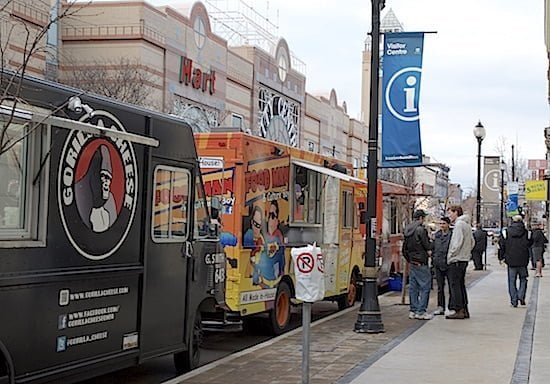
Hamilton’s liberal laws have allowed the city to be at the forefront of the food-truck movement in Ontario. (Julia Pelish/Vacay.ca)
Building an attractive downtown has changed the city for residents. A hope for Tourism Hamilton is business travellers who arrive for a convention will opt to return for a more leisurely stay. “If they have a fabulous time, then they are coming back with their families,” tourism manager Carrie Brooks-Joiner says.
As the need for more hotel room bookings shows, most visitors currently are not spending the night and that means they are less likely to purchase dinner.
When I wrote Hamilton has “sparse” dining options, it’s a statement made in direct comparison to Toronto’s West Queen West district, an area that was derelict less than 20 years ago and is now home to the second “Coolest Neighborhood in the World,” according to Vogue Magazine.
While “sparse” is a subjective word that could have been better chosen, downtown Hamilton still has yet to place a restaurant on a credibly curated ranking of the nation’s dining scene (the OpenTable list doesn’t include Montreal’s Joe Beef or Toque!, two of the undisputed best restaurants in the country, and is often dismissed by the culinary world for those omissions and others).
Change can happen fast. Collaboration helps it happen faster.
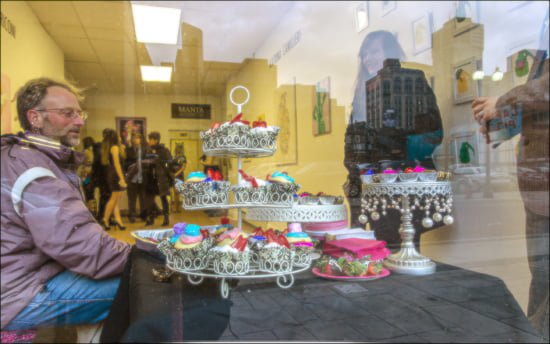
Galleries such as Mantra Contemporary feature artwork that promotes local artists and encourages participation in Hamilton’s growing arts scene. (Julia Pelish/Vacay.ca)
When Hamilton has stopped “emerging” and is deemed to have emerged by the standards its leaders have set, there will be other challenges and opportunities.
Space will be an issue. Variety of programming will require creative solutions to keep things fresh each year. Downtown congestion could lead to limited parking and a call for more than one car-free day a year. A local group may complain the revitalized waterfront is so overrun with tourists there’s no room for residents to enjoy it.
Rehabilitating Hamilton’s Image
Perhaps by 2021 Hamilton will have one or more of those problems. For now, it has an image issue more than anything, which I would suggest isn’t helped by the hurling of insults or severe comments, or plotting a restaurant boycott based on a rush to judgment.
Such a response might raise concerns from people observing from the outside and it is those outsiders, those strangers who choose to come to visit, who will play a major role in changing perceptions of the city and helping to grow tourism revenue. As Marini points out, it’s working already, with an influx of talent from around Canada.
“Investors have brought in a high-calibre of culinary talent from across the country who are now calling Hamilton home,” says Marini, who has helped to coordinate Nosh Hamilton, called “A Celebration of the City’s Rising Food Scene.” It is the first culinary week event in Hamilton.
When MacKay launched his Prairie Feast in Saskatoon in 2015, he knew he couldn’t rely on local chefs to get the story out. So he invited a coterie of his culinary friends from around the country to join him in throwing a big event celebrating Saskatchewan’s bounty of flavours and ingredients. Those influencers, such as Lynn Crawford and Connie DeSousa, can spread the word far and wide. Cultivating their allegiance helped MacKay boost the awareness of what’s happening in his community.
A similar tactical approach may help Hamilton. While Nosh Hamilton has an outstanding list of events, it is short on chefs from afar. That limits its ability to draw interest from outside Hamilton. At the moment, the focus is still on rehabilitating the downtown.
“Tourism is one aspect of it. Sure, someone might stay for a night or two, but what are we saying from a sustainable perspective?” Marini says.
Tourism Hamilton representatives said the city’s culinary tourism goals are about “celebrating and expanding locally grown” products and experiences, not bringing in big names from outside. Moran, meanwhile, says the city’s humility keeps it from boasting too much about what it offers.
“Hamilton has a character that, as you saw, can be very passionate, but it is a city with a modest and relatively humble character. Although we are a city with a deep culture scene, we don’t make a big, pretentious deal about it and that is reflected in the food, where it is comfortable if you dine in the restaurants here,” he says. “Our culture is the other side of the Toronto coin, where we are very much like Toronto on some levels, but where Toronto is represented as the big Canadian city we are represented much more modestly.”

“The Phantom of the Snow” is a circa-1888 painting by William Blair Bruce on display at the Art Gallery of Hamilton. (Julia Pelish/Vacay.ca)
Staying modest is a wonderful human characteristic, but marketing and promotion requires some amount of chest-thumping. Hamilton may be a great place for locals to dine, but it isn’t there yet as a culinary destination. Depending on what city you are comparing it to, Hamilton could be close to the distinction as a hotbed for food tourism or far away. The tourism strategy plan does recognize the need for development, though. It states a greater understanding of the agri-tourism and culinary sectors “will involve bringing together a disparate group of stakeholders (many who do not perceive themselves as being in the tourism business) and identifying the strengths and weaknesses of these sectors from a tourism perspective, and where the opportunities lie.”
Identifying Culinary Tourism Goals in Hamilton
The report also points to a need to spotlight the city’s food heritage and its distinct products. It states, “Equally, there is limited emphasis on ‘local foods’ as part of the overall experience or as an attractor, although events such as Farm Crawl, and those organized by Dish Crawl and Pop Up Hamilton, are beginning to raise the profile of agri-tourism and local foods.”
Restaurants such as Rapscallion, owned by the respected Other Bird food group, and Brux House will benefit from an interest in the region’s agri-tourism and local food scene. The food-truck movement has been a success for Hamilton but food trucks are no longer unique from a visitor perspective. Initiatives focused on local foods remain popular and sustainable. They have helped restaurants in nearby Stratford broaden their client base. Brooks-Joiner notes Hamilton has been “historically known for the production of mustard and certainly the condiment market is seeing growth.” Artisanal mustards, jams and jellies are being produced in the area, and with their production comes the opportunity for creative culinary arts professionals to imagine a compelling and distinct way to market them to potential tourists.
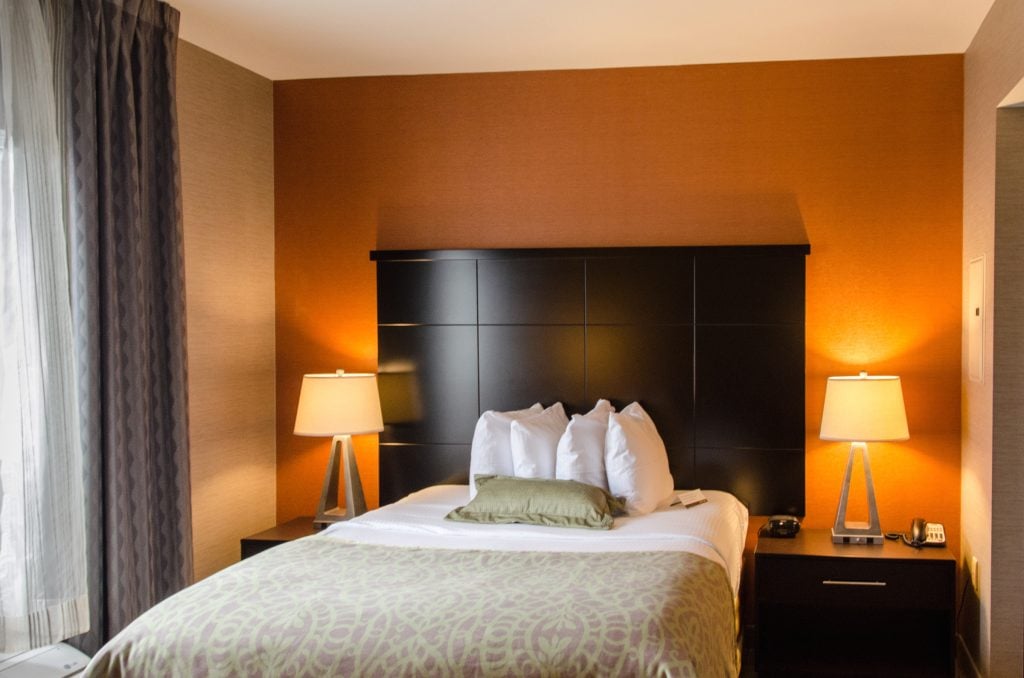
Staybridge Suites, which features comfortable beds in a great location, is one of the downtown Hamilton hotels that will benefit from a change in perception of the city. (Julia Pelish/Vacay.ca)
For Hamilton, such initiatives remain largely in the discussion or development stage. What is already in place are restaurants, some waiting for diners and for aficionados from outside of the city to visit. In response to the controversy caused by the article on Born & Raised, Colacitti published a map noting all of the quality restaurants in the vicinity of his establishment, as well as comments underscoring his support for Hamilton’s dining scene.
“This is where my family is from and I love this city. The energy in Hamilton’s food scene has been thriving for some time now thanks to a number of catalysts sparking the movement and I am grateful to have been welcomed into the local culinary scene,” Colacitti wrote on social media. “I wanted to acknowledge and stand alongside my peers, neighbours and people who work so hard to bring attention to this community.”
Hopefully, the gesture is returned, and Born & Raised sees visitation from local restaurant-goers.
“The scene has been growing steadily for the past seven or eight years,” Marini says. “People get that we’re in this together. And I think that was the big reaction to the initial article you wrote. Here, you can play a part in recreating this city and in the renaissance of this city, and that’s been happening. I don’t think there was a recognition or credit due to those who have been working and sweating for a long time to build things here. We’re extremely proud and happy to have Vittorio as part of the scene but it’s been going strong for seven years or so now.”
I came to meet Colacitti at Born & Raised the same way I usually meet chefs. A recent article I wrote on another culinary talent — this time Calgary’s Roy Oh — received attention and I was recommended to visit Colacitti’s two restaurants, The Good Son in Toronto and Born & Raised. With a tight schedule during a recent trip from Vancouver to southern Ontario, I had about two hours to spend in Hamilton, limiting me to only one restaurant visit. Never thinking a piece praising one restaurant owner and his pride for the city would cause an eruption of rage, I didn’t mention other dining choices, writing instead on Colacitti’s shift of focus from Toronto to Hamilton and the reasons for it — one being greater opportunity in a much smaller city with, logically, far fewer choices than the most populous place in Canada.
From my interaction with him, Colacitti came across the way most chefs do: As a passionate, heartfelt guy who wants to be involved in the community and thoroughly enjoys the nurturing act of feeding people. Hamiltonians should give him the chance to do so. Not for his benefit or based on a recommendation by me or anyone else, but because businesses that are deserving of success help to improve the quality of life for everyone. Sometimes, as Hamiltonians appear to know well, collaboration doesn’t need any more formality than neighbours walking through the door of a local business and welcoming the owner to show them what he has to offer. All sorts of fun and beautiful things can transpire through such simple acts of grace.
Support the ‘Inspired Cooking’ Project to Fight Cancer
Vacay.ca has teamed with InspireHealth to produce one of the most exciting and important cookbooks to ever hit the bookshelves in Canada. “Inspired Cooking” will launch in fall 2016, featuring profiles of 20 of Canada’s greatest chefs discussing what nutrition means to them. More than 60 recipes will be included in the stunning cookbook published by Vancouver-based Fresh Air Publishing. All proceeds from the charity cookbook go toward InspireHealth, a government-funded, not-for-profit agency that provides supportive cancer care to patients across Canada. The cookbook was inspired by Julia Pelish-Brijbassi, Vacay.ca’s co-founder who passed away in March 2016 after an 11-month battle with brain cancer. “Inspired Cooking” is edited by her husband, Vacay.ca’s Adrian Brijbassi. Order your copy of the book now and learn more about the project at InspiredCooking.ca.
